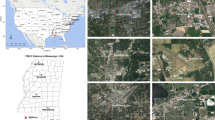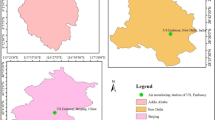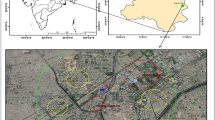Abstract
The present study analyses daily and seasonal variation of PM2.5 at three stations of megacity Mumbai -Sion, Bandra and U.S. embassy, which are around three km apart from each other with different local conditions, for 2015–2018. The daily average mean concentration for Sion, Bandra and U.S. embassy are 141.95 μg/m3, 105.18 μg/m3 and 53.37 μg/m3. The highest seasonal average concentration is observed in winter at Sion with a value of 175.45 µg/m3, which is around three times of the limit for daily mean given by the Central Pollution Control Board (CPCB) (i.e., 60 µg/m3). The study classifies Sea breeze day (SBD) and non-sea breeze days (NSBD) to understand the associated variation of PM2.5. The increase in PM2.5 concentrations is found to be in agreement with many diseases and vehicular registrations over Mumbai. The study also used back trajectory and concentrated weighted trajectory (CWT) analysis to understand the source regions of transported pollution.








Similar content being viewed by others
References
Apte JS, Kirchstetter TW, Reich AH, Deshpande SJ, Kaushik G, Chel A, Marshall JD, Nazaroff WW (2011) Concentrations of fine, ultrafine, and black carbon particles in auto-rickshaws in New Delhi, India. Atmos Environ 45(26):4470–4480. https://doi.org/10.1016/j.atmosenv.2011.05.028
Brook RD, Franklin B, Cascio W, Hong Y, Howard G, Lipsett M, Luepker R, Mittleman M, Samet J, Smith SC Jr, Tager I (2004) Air pollution and cardiovascular disease: a statement for healthcare professionals from the Expert Panel on Population and Prevention Science of the American Heart Association. Circulation 109(21):2655–2671. https://doi.org/10.1161/01.CIR.0000128587.30041.C8
Brunekreef B, Holgate ST (2002) Air Pollution and Health. Lancet 360(9341):1233–1242. https://doi.org/10.1016/S0140-6736(02)11274-8
Burnett R, Chen H, Szyszkowicz M, Fann N, Hubbell B, Pope CA, Apte JS, Brauer M, Cohen A, Weichenthal S, Coggins J (2018) Global estimates of mortality associated with long-term exposure to outdoor fine particulate matter. Proc Natl Acad Sci 115(38):9592–9597
Burnett RT, Pope CA III, Ezzati M, Olives C, Lim SS, Mehta S, Shin HH, Singh G, Hubbell B, Brauer M, Anderson HR (2014) An integrated risk function for estimating the global burden of disease attributable to ambient fine particulate matter exposure. Supplemental material. Environ Health Perspect 122(4):397–403
Cao J, Chow JC, Lee FSC, Watson JG (2013) Evolution of PM2.5 measurements and standards in the U.S. and future perspectives for China. Aerosol Air Qual Res 13:1197–1211. https://doi.org/10.4209/aaqr.2012.11.0302
Census (2011) The Registrar General & Census Commissioner, India. http://www.censusindia.gov.in/2011census/population_enumeration.html
Cheng I, Zhang L, Blanchard P, Dalziel J, Tordon R (2013) Concentration Weighted Trajectory approach to identifying potential sources of speciated atmospheric mercury at an urban coastal site in NovaScotia, Canada. Atmos Chem Phys 13:6031–6048. https://doi.org/10.5194/acp-13-6031-2013
Cheng Z, Luo L, Wang S, Wang Y, Sharma S, Shimadera H, Wang X, Bressi M, de Miranda RM, Jiang J, Zhou W (2016) Status and characteristics of ambient PM2. 5 pollution in global megacities. Environ Int 89:212–221. https://doi.org/10.1016/j.envint.2016.02.003
Chhabra SK, Chhabra P, Rajpal S, Gupta RK (2001) Ambient air pollution and chronic respiratory morbidity in Delhi. Arch Environ Health: Int J 56(1):58–64
Ching J, Kajino M (2018) Aerosol mixing state matters for particles deposition in human respiratory system. Sci Rep 8(1):1–11. https://doi.org/10.1038/s41598-018-27156-z
Choudhury G, Tyagi B, Singh J, Sarangi C, Tripathi SN (2019) Aerosol-orography-precipitation–A critical assessment. Atmos Environ 214:116831
Choudhury G, Tyagi B, Vissa NK, Singh J, Sarangi C, Tripathi SN, Tesche M (2020) Aerosol-enhanced high precipitation events near the Himalayan foothills. Atmos Chem Phys 20(23):15389–15399
Cohen A et al (2017) Estimates and 25-year trends of the global burden of disease attributable to ambient air pollution: an analysis of data from the Global Burden of Diseases Study 2015. Lancet 389(10082):1907–1918
CPCB Report (2009) Central Pollution Control Board, India: National Ambient Air Quality Standards (NAAQS). Gazette notification, New Delhi
CPCB report (2015) National Air Quality Index. Series: CUPS/82/2014–15. 58
Dholakia HH, Jalan I, Garg A (2020) Extreme Events and Health in Mumbai, India. In: Extreme Weather Events and Human Health. Springer, Cham, pp 355–367
Dong GH, Qian Z, Xaverius PK, Trevathan E, Maalouf S, Parker J, Yang L, Liu MM, Wang D, Ren WH, Ma W (2013a) Association between long-term air pollution and increased blood pressure and hypertension in China. Hypertension 61(3):578–584
Dong Z, Yu X, Li X, Dai J (2013b) Analysis of variation trends and causes of aerosol optical depth in Shaanxi Province using MODIS data. Chin Sci Bull 58(35):4486–4496. https://doi.org/10.1007/s11434-013-5991-z
Draxler RR (1999) HYSPLIT4 User's Guide. NOAA Tech. Memo. ERL ARL-230. NOAA Air Resources Laboratory, Silver Spring, MD
Draxler RR, Hess G (1997) Description of the HYSPLIT_4 modeling system NOAA Tech. Memo. ERL ARL-224, NOAA Air Resources Laboratory, Silver Spring, MD, 24
Fettweis M, Francken F, Pison V, Van den Eynde D (2006) Suspended particulate matter dynamics and aggregate sizes in a high turbidity area. Mar Geol 235(1–4):63–74. https://doi.org/10.1016/j.margeo.2006.10.005
Forouzanfar MH et al (2015) Global, regional, and national comparative risk assessment of 79 behavioural, environmental and occupational, and metabolic risks or clusters of risks in 188 countries, 1990–2013: a systematic analysis for the Global Burden of Disease Study 2013. Lancet 386(10010):2287–2323
Forouzanfar MH et al (2016) Global, regional, and national comparative risk assessment of 79 behavioural, environmental and occupational, and metabolic risks or clusters of risks, 1990–2015: a systematic analysis for the Global Burden of Disease Study 2015. Lancet 388(10053):1659–1724
Frühbeck G, Catalán V, Rodríguez A, Gómez-Ambrosi J (2018) Adiponectin-leptin ratio: a promising index to estimate adipose tissue dysfunction. Relation with obesity-associated cardiometabolic risk. Adipocyte 7(1):57–62
Furberg M, Steyn DG, Baldi M (2002) The climatology of sea breezes on Sardinia. Int J Climatol 22(8):917–932. https://doi.org/10.1002/joc.780
Gogikar P, Tyagi B (2016) Assessment of particulate matter variation during 2011–2015 over a tropical station Agra, India. Atmos Environ 147:11–21. https://doi.org/10.1016/j.atmosenv.2016.09.063
Guerreiro CBB, Foltescu V, de Leeuw F (2014) Air quality status and trends in Europe. Atmos Environ 98:376–384. https://doi.org/10.1016/j.atmosenv.2014.09.017
Gummeneni S, Yusup YB, Chavali M, Samadi SZ (2011) Source apportionment of particulate matter in the ambient air of Hyderabad city, India. Atmos Res 101(3):752–764. https://doi.org/10.1016/j.atmosres.2011.05.002
Guo Y, Tong S, Zhang Y, Barnett AG, Jia Y, Pan X (2010) The relationship between particulate air pollution and emergency hospital visits for hypertension in Beijing, China. Sci Total Environ 408(20):4446–4450. https://doi.org/10.1016/j.scitotenv.2010.06.042
Gupta K (2007) Urban flood resilience planning and management and lessons for the future: A case study of Mumbai, India. Urban Water J 4:183–194
Gurjar BR, Ravindra K, Nagpure AS (2016) Air pollution trends over Indian megacities and their local-to-global implications. Atmos Environ 142:475–495
Guttikunda SK, Goel R, Pant P (2014). Nature of air pollution, emission sources, and management in the Indian cities. Atmos Environ 95:501–510
Heyder J (2004) Deposition of inhaled particles in the human respiratory tract and consequences for regional targeting in respiratory drug delivery. Proc Am Thorac Soc 1(4):315–320. https://doi.org/10.1513/pats.200409-046TA. http://www.imdpune.gov.in/hydrology/normal/norclim.html
Hubbard MC, Cobourn WG (1998) Development of a regression model to forecast ground-level ozone concentration in Louisville, KY. Atmos Environ 32(14–15):2637–2647. https://doi.org/10.1016/S1352-2310(97)00444-5
Iyer L, Macomber JD, Arora N (2009) Dharavi: Developing Asia's Largest Slum. HBS Case, (710–004). https://ssrn.com/abstract=1444407. Accessed 26 Jan 2020
James PA, Oparil S, Carter BL, Cushman WC, Dennison-Himmelfarb C, Handler J, Lackland DT, LeFevre ML, MacKenzie TD, Ogedegbe O, Smith SC (2014) 2014 evidence-based guideline for the management of high blood pressure in adults: report from the panel members appointed to the Eighth Joint National Committee (JNC 8). JAMA 311(5):507–520
Jang E, Do W, Park G, Kim M, Yoo E (2017) Spatial and temporal variation of urban air pollutants and their concentrations in relation to meteorological conditions at four sites in Busan, South Korea. Atmos Pollut Res 8(1):89–100. https://doi.org/10.1016/j.apr.2016.07.009
Joseph J, Patil RS, Gupta SK (2009) Estimation of air pollutant emission loads from construction and operational activities of a port and harbour in Mumbai, India. Environl Monit Assess 159(1–4):85. https://doi.org/10.1007/s10661-008-0614-x
Kalyan M, Dhore P, Purandare V, Deshpande S, Unnikrishnan AG (2020) Obesity and its link to undiagnosed diabetes mellitus and hypertension in rural parts of western India. Indian J Endocrinol Metab 24(2):155
Kothai P, Saradhi IV, Pandit GG, Markwitz A, Puranik VD (2011) Chemical characterization and source identification of particulate matter at an urban site of Navi Mumbai, India. Aerosol Air Qual Res 11(5):560–569. https://doi.org/10.4209/aaqr.2011.02.0017
Kumar AV, Patil RS, Nambi KSV (2001) Source apportionment of suspended particulate matter at two traffic junctions in Mumbai, India. Atmos Environ 35(25):4245–4251. https://doi.org/10.1016/S1352-2310(01)00258-8
Kumar R, Joseph AE (2006) Air Pollution Concentrations of PM 2.5, PM 10 and NO 2 at Ambient and Kerbsite and Their Correlation in Metro City–Mumbai. Environ Monit Assess 119(1–3):191–199. https://doi.org/10.1007/s10661-005-9022-7
Lai TC, Chiang CY, Wu CF, Yang SL, Liu DP, Chan CC, Lin HH (2016) Ambient air pollution and risk of tuberculosis: a cohort study. Occup Environ Med 73(1):56–61. https://doi.org/10.1136/oemed-2015-102995
Lelieveld J, Evans JS, Fnais M, Giannadaki D, Pozzer A (2015) The contribution of outdoor air pollution sources to premature mortality on a global scale. Nature 525(7569):367. https://doi.org/10.1038/nature15371
Lim S et al (2013) A comparative risk assessment of burden of disease and injury attributable to 67 risk factors and risk factor clusters in 21 regions, 1990–2010: a systematic analysis for the Global Burden of Disease Study 2010. Lancet 380(9859):2224–2260
Lin H, Guo Y, Kowal P, Airhihenbuwa CO, Di Q, Zheng Y, Zhao X, Vaughn MG, Howard S, Schootman M, Salinas-Rodriguez A (2017) Exposure to air pollution and tobacco smoking and their combined effects on depression in six low-and middle-income countries. Br J Psychiatry 211(3):157–162
Liu C, Chen R, Sera F, Vicedo-Cabrera AM, Guo Y, Tong S, Coelho MS, Saldiva PH, Lavigne E, Matus P, Valdes Ortega N (2019) Ambient particulate air pollution and daily mortality in 652 cities. N Engl J Med 381(8):705–715
Lueker J, Bardhan R, Sarkar A, Norford L (2020) Indoor air quality among Mumbai’s resettled populations: Comparing Dharavi slum to nearby rehabilitation sites. Build Environ 167:106419
Luther ME, O’Brien JJ (1985) A model of the seasonal circulation in the Arabian Sea forced by observed winds. Prog Oceanogr 14:353–385. https://doi.org/10.1016/0079-6611(85)90017-5
Mahapatra PS, Sinha PR, Boopathy R, Das T, Mohanty S, Sahu SC, Gurjar BR (2018) Seasonal progression of atmospheric particulate matter over an urban coastal region in peninsular India: Role of local meteorology and long-range transport. Atmos Res 199:145–158. https://doi.org/10.1016/j.atmosres.2017.09.001
Markku K (2015) China’s choking cocktail. Nature 526:497–499. https://doi.org/10.1038/526497a
Marrapu P, Cheng Y, Beig G, Sahu S, Srinivas R, Carmichael GR (2014) Air quality in Delhi during the Commonwealth Games. Atmos Chem Phys 14(19):10619–10630
Matsui H, Koike M, Kondo Y, Takegawa N, Fast JD, Pöschl U, Garland RM, Andreae MO, Wiedensohler A, Sugimoto N, Zhu T (2010) Spatial and temporal variations of aerosols around Beijing in summer 2006: 2. Local and column aerosol optical properties. J Geophys Res Atmos 115(D22). https://doi.org/10.1029/2010JD013895
Ostro B, Spadaro JV, Gumy S, Mudu P, Awe Y, Forastiere F, Peters A (2018) Assessing the recent estimates of the global burden of disease for ambient air pollution: methodological changes and implications for low-and middle-income countries. Environ Res 166:713–725
Papanastasiou DK, Melas D (2008) Daily ozone forecasting in an urban area using meteorological and pollution data. Fresenius Environ Bull 17(3):364–370. WOS:000255898400014
Papanastasiou DK, Melas D (2009) Climatology and impact on air quality of sea breeze in an urban coastal environment. Int J Climatol 29(2):305–315. https://doi.org/10.1002/joc.1707
Peng Z, Liu C, Xu B, Kan H, Wang W (2017) Long-term exposure to ambient air pollution and mortality in a Chinese tuberculosis cohort. Sci Total Environ 580:1483–1488
Police S, Sahu SK, Tiwari M, Pandit GG (2018) Chemical composition and source apportionment of PM2. 5 and PM2. 5–10 in Trombay (Mumbai, India), a coastal industrial area. Particuology 37:143–153. https://doi.org/10.1016/j.partic.2017.09.006
Pope CA III, Burnett RT, Thun MJ, Calle EE, Krewski D, Ito K, Thurston GD (2002) Lung cancer, cardiopulmonary mortality, and long-term exposure to fine particulate air pollution. JAMA 287(9):1132–1141. https://doi.org/10.1001/jama.287.9.1132
Pope CA III, Ezzati M, Dockery DW (2009) Fine-particulate air pollution and life expectancy in the United States. N Engl J Med 360(4):376–386. https://doi.org/10.1056/NEJMsa0805646
Praja health report – Report on the state of health of Mumbai (2016, 2017 and 2018). https://www.praja.org/praja_docs/praja_downloads/Report%20on%20The%20STATE%20of%20HEALTH%20in%20Mumbai.pdf. Accessed 1 Jan 2020
Ramanathan V, Chung C, Kim D, Bettge T, Buja L, Kiehl JT, Washington WM, Fu Q, Sikka DR, Wild M (2005) Atmospheric brown clouds: Impacts on South Asian climate and hydrological cycle. Proc Natl Acad Sci 102(15):5326–5333. https://doi.org/10.1073/pnas.0500656102
Sandeep P, Saradhi IV, Pandit GG (2013) Seasonal variation of black carbon in fine particulate matter (PM 2.5) at the tropical coastal city of Mumbai, India. Bull Environ Contam Toxicol 91(5):605–610. https://doi.org/10.1007/s00128-013-1108-2
Simpson JE (1994) Sea breeze and local winds. Cambridge University Press, Page, p 1
Singh J, Tyagi B (2021) Transformation of air quality over a coastal tropical station Chennai during COVID-19 lockdown in India. Aerosol Air Qual Res 21(4):200490
Steeneveld GJ, Klompmaker JO, Groen RJ, Holtslag AA (2018) An urban climate assessment and management tool for combined heat and air quality judgements at neighbourhood scales. Resour Conserv Recycl 132:204–217
Stein AF, Draxler RR, Rolph GD and Stunder BJ, Cohen MD, Ngan F (2015) NOAA'S HYSPLIT atmospheric transport and dispersion modeling system. B Am Meteorol Soc 96:2059–2077
Sudeepkumar BL, Babu CA, Varikoden H (2021) Thermodynamic structure of monsoon boundary layer over the west coast of India. Atmos Res 261:105748
Tie X, Wu D, Brasseur G (2009) Lung cancer mortality and exposure to atmospheric aerosol particles in Guangzhou, China. Atmos Environ 43(14):2375–2377. https://doi.org/10.1016/j.atmosenv.2009.01.036
Vissa NK, Tyagi B (2021) Aerosol dipole pattern over India: consequences on rainfall and relation with wind circulations. Acta Geophys 69(6):2475–2482
Watson T (2014) Environment: breathing trouble. Nature 513(7517):S14–S15. https://doi.org/10.1038/513S14a
WHO Regional Office for Europe (2006) Air Quality Guidelines: Global Update 2005: particulate matter, ozone, nitrogen dioxide, and sulfur dioxide. Copenhagen: WHO Regional Office for Europe http://www.euro.who.int/__data/assets/pdf_file/0005/78638/E90038.pdf?ua=1. Accessed 28 Jan 2020
Wang B, Xu D, Jing Z, Liu D, Yan S, Wang Y (2014) Effect of long-term exposure to air pollution on type 2 diabetes mellitus risk: a systemic review and meta-analysis of cohort studies. Eur J Endocrinol 171(5):R173–R182
Weinmayr G, Hennig F, Fuks K, Nonnemacher M, Jakobs H, Möhlenkamp S, Erbel R, Jöckel KH, Hoffmann B, Moebus S (2015) Long-term exposure to fine particulate matter and incidence of type 2 diabetes mellitus in a cohort study: effects of total and traffic-specific air pollution. Environ Health 14(1):1–8
WHO Report (2016) Global, T.B. Report 2016. Methods used by WHO to estimate the global burden of TB disease, Glaziou P, Sismanidis C, Zignol M, Floyd K, Global TB Programme, WHO, Geneva, Switzerland
Acknowledgements
Authors want to acknowledge Maharashtra Pollution Control Board (MPCB); the U.S. Department of State for AirNow; Ministry of Transport, Maharashtra Government, India; Praja Foundation, India for providing the data used in the present study. Mr. Atique Barudgar wants to acknowledge National Institute of Technology Rourkela for providing research facilities.
Author information
Authors and Affiliations
Contributions
Atique Barudgar: Data Collection, Figure preparation, Writing- Original draft preparation, Jyotsna Singh: Software, Figure preparation, Writing- Original draft preparation, Bhishma Tyagi: Conceptualization, Software, Figure Preparation, Methodology, Writing- Original draft preparation, Writing- Reviewing and Editing.
Corresponding author
Ethics declarations
Conflict of Interest/Competing of interest
On behalf of all authors, the corresponding author states that there is no conflict of interest. The authors declare that they have no known competing financial interests or personal relationships that could have appeared to influence the work reported in this paper.
Additional information
Publisher's Note
Springer Nature remains neutral with regard to jurisdictional claims in published maps and institutional affiliations.
Rights and permissions
About this article
Cite this article
Barudgar, A., Singh, J. & Tyagi, B. Variability of Fine Particulate Matter (PM2.5) and its Association with Health and Vehicular Emissions Over an Urban Tropical Coastal Station Mumbai, India. Thalassas 38, 1067–1080 (2022). https://doi.org/10.1007/s41208-022-00442-4
Received:
Revised:
Accepted:
Published:
Issue Date:
DOI: https://doi.org/10.1007/s41208-022-00442-4




